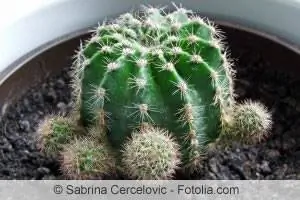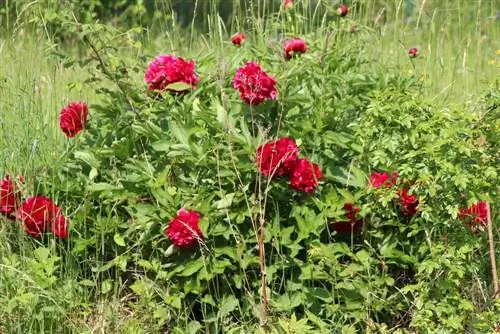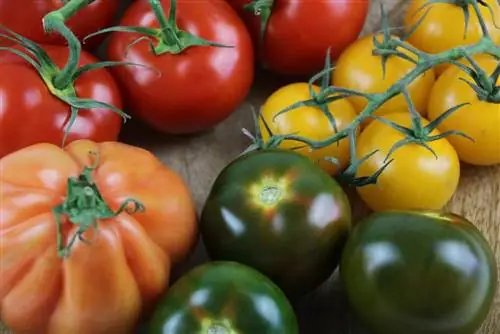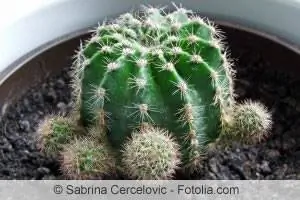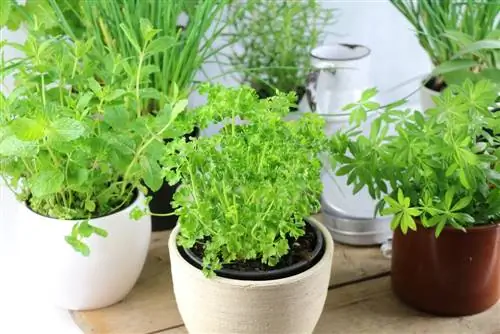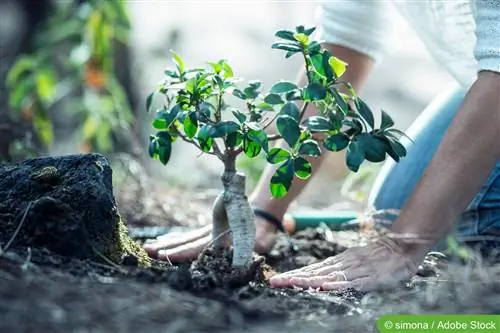- Author admin [email protected].
- Public 2023-12-17 03:39.
- Last modified 2025-06-01 06:48.
Cacti are rightly considered to be the representatives of the frugal houseplant par excellence. This reputation is based primarily on their ability to store water in the trunk, leaves or shoots. In this way they survive the bone-dry desert summers in their homeland until the next rainy season. If you want to plant the prickly flower beauties at home, you should keep in mind that the succulents are not native here. Therefore, there are various aspects to consider in order to plant cacti correctly - here's how!
Plants
Immigrated from the barren regions of North and South America, the Central European climate conditions are not per se suitable for the cultivation of cacti. In order to plant the succulents professionally, the first thing to look at is the choice of location. This is where the course is set for successful cultivation over many years. Only then do the quality of the substrate and the condition of the planter come into play.
Location
Light and sun are of vital importance for almost all cacti of more than 3,000 species. This primarily applies to the main growing season from March to September. Different signs apply in autumn and winter because the plants then enter a growth break. Compact growth habit, beautifully colored epidermis and a magnificent thorny coat develop in proportion to the amount of UV light. Succulents are much more flexible when it comes to temperature conditions. Cacti develop their optimum in the following places:
- Sunny location with at least 4 to 6 hours of sunshine per day
- The sunny windowsill, the bright greenhouse or the sun-filled winter garden are recommended
- The sun-drenched balcony and terrace are ideal until autumn
- Locations behind tinted windows or in the shade of balconies and awnings are unfavorable
- Temperatures of 15 to 35 degrees Celsius create the best growth
With regard to temperature conditions, cacti prove to be extremely flexible. Even extreme fluctuations do not cause any problems for these prickly natural beauties. A combination of lack of light and heat creates the worst possible conditions for succulents. The result is long, weak and very thin horny shoots because the affected cactus desperately searches for sunlight.
Tip:
During the hibernation period from October to February, the low amount of watering and cooler temperatures between 5 and 15 degrees Celsius reduce the need for UV light. A bright staircase, the windowsill in the bedroom or the minimally heated greenhouse offer perfect location conditions.
Tips for substrate & Co
There are many myths surrounding the best possible composition of the substrate for cacti. If you look around among hobby gardeners with extensive collections, you will discover as many recipes as there are cactus lovers. There is no silver bullet for the ultimate potting soil. The following tips on substrate and planters may serve as a guide on the way to your individual secret recipe.
This is what the perfect earth must be able to do:
- Giving support to the cactus
- Be easy to root
- Have first-class ventilation
- Absorb water even after a long dry period
- Keep watering water for some time without causing waterlogging
In order to create such a loose and structurally stable mixture, the following components come into consideration:
- Compost after a ripening period of at least 3 years
- Peat in the form of standard soil, also known as peat culture substrate (TKS1)
- Lava granules, as a mineral component from the heart of the earth
- Expanded clay, light, mineral and always neutral
- Pumice, the lightest and airiest effluent rock
- Vermiculite, the crystalline clay mineral as a buffer against undesirable acidification
Since only a few cacti do not need humus, an organic component in the substrate must not be missing. This is where compost and peat come into play, which - unlike other house plants - do not play a solo role here. The mineral additives are indispensable as a balancing counterweight.
Proven standard blends
Once the ingredients have been determined, the question arises as to their dosage. The following three mixtures have proven themselves very well in practice:
- Purely mineral mixture: 40-50% lava or expanded clay, 30-40% pumice, 10-20% quartz sand, 5% vermiculite
- Organic-mineral: 30% compost, 30% peat (TKS1), 20% pumice, 20% lava granules
- Organic-mineral: 60% cactus soil, 20% lava or expanded clay, 20% pumice
Commercial potting soil is usually heavily pre-fertilized and therefore unsuitable for succulents. The excess of humus causes mast growth, which results in rot. You should not use building sand as sand because it contains plenty of lime. The result is a pH value that is much too high, the iron in the fertilizer is fixed and the cactus suffers from chlorosis.
Tip:
The pH value of a first-class cactus substrate must not be higher than 7. Using a simple test set from the garden center, you can determine the value yourself using an uncomplicated coloring reaction.
Planter
The size and shape of the planter depends primarily on the habit and root of the cactus. For example, a columnar succulent requires a sturdy pot that won't tip over. If you follow the following rules of thumb, nothing can go wrong:
- The pot diameter for plants smaller than 100 cm corresponds to 1/3 of the height
- The pot diameter for plants over 100 cm high is 1/4 to 1/6
- Shallow roots grow better in wide bowls
- Beet roots require an extra deep container
When it comes to the material, aesthetics are not the only deciding factor. Plastic planters allow moisture to be distributed more evenly throughout the substrate. In the clay pot, the water also evaporates through the pores, so more frequent watering is necessary. Regardless of which material you prefer, there should always be an opening in the floor for water drainage.
Plant correctly
Once you have decided on the location, the perfect substrate and the suitable pot, the actual planting is very straightforward. This is how it works:
- Do not water the cactus in the days before potting
- Spread a 5 centimeter high layer of expanded clay over the water drain as drainage
- Fill the preferred substrate up to half the height of the pot
- Make a depression in the soil and insert the succulent
- Plant so far that the plant is as deep as before
Use the planting wood to press the substrate a little further so that no cavities form. After 3 to 4 days, water the cactus moderately.
Tip:
When planting, several layers of newspaper or two thick polystyrene sheets serve as protection against sharp thorns so that you can touch the cactus from both sides.
Plants in the bed
Outdoor cacti are causing a stir in the garden, as the hardy species and varieties are still largely unknown. In order to properly plant specialists such as the mountain cactus or some opuntias, the location should be sunny and protected from rain. A dry stone wall, a gravel bed on a slope or an area under a roof overhang are ideal options. A sandy, dry soil with humus-rich components creates the best conditions for growth. How to proceed step by step:
- Optimize sandy soil with clay, compost or peat
- Improve heavy soil by adding grit, gravel, lava, pumice or expanded clay
- Create drainage in each planting pit
- Water planted cacti only after a few days
In the garden, a layer of mulch made of coarse materials is beneficial. The soil stays warm longer and weeds are effectively suppressed. A cover made of decorative gravel, lightened by stones of different sizes, ensures a decorative appearance.
Experienced hobby gardeners plant the succulents in cavities in a dry stone wall. To do this, you use special plant bags that are available from specialist retailers. In this case, the substrate corresponds to a recommended mixture for pot culture. It is particularly the small cactus varieties that do their best in this location.
Conclusion
For cacti to live up to their reputation as undemanding ornamental plants, their location should be sunny and the substrate should be airy. If the temperatures are proportional to the amount of light available, a cactus feels comfortable and thrives. If you plant your prickly succulents following these instructions, the effort required for care will be reduced to a minimum. This applies to both indoor cultivation and care in the garden bed or dry stone wall. If you follow the tips on substrate etc., you will create the right mixture for each of the more than 3,000 species and choose the perfect planter.

